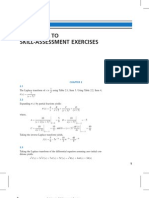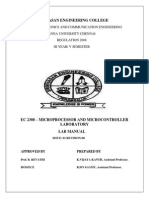VHDL - 1100 Sequence Detector - Electrical Engineering Stack Exchange
VHDL - 1100 Sequence Detector - Electrical Engineering Stack Exchange
Uploaded by
Maddy TrichyCopyright:
Available Formats
VHDL - 1100 Sequence Detector - Electrical Engineering Stack Exchange
VHDL - 1100 Sequence Detector - Electrical Engineering Stack Exchange
Uploaded by
Maddy TrichyOriginal Description:
Original Title
Copyright
Available Formats
Share this document
Did you find this document useful?
Is this content inappropriate?
Copyright:
Available Formats
VHDL - 1100 Sequence Detector - Electrical Engineering Stack Exchange
VHDL - 1100 Sequence Detector - Electrical Engineering Stack Exchange
Uploaded by
Maddy TrichyCopyright:
Available Formats
11/19/2014
vhdl - 1100 Sequence Detector - Electrical Engineering Stack Exchange
sign up
Electrical Engineering Stack Exchange is a question and answer site for electronics and electrical
engineering professionals, students, and enthusiasts. It's 100% free, no registration required.
log in
tour
help
Take the 2-minute tour
1100 Sequence Detector
I have to design a 1100 sequence detector using Mealy model and JK Flip-Flops. Here is the state diagram:
And based on this diagram, I obtain following input statements for flip-flop inputs (A and B flip-flops):
JA = A and X
KA = B
--------------JB = A xor X
KB = A nand X
Finally, VHDL implementation gives these result:
But it catches "110" instead of "1100". When I implement same state diagram using case...when structure, it gives correct result but
I have to use logic gates & JK flip-flops.
How should I change this design? Is there something wrong or something I missed?
EDIT: I need obtain functions JA, KA, JB, KB (which are inputs of JK flip-flops) in terms of present states A,B and input sequence X.
http://electronics.stackexchange.com/questions/93689/1100-sequence-detector
1/3
11/19/2014
vhdl - 1100 Sequence Detector - Electrical Engineering Stack Exchange
vhdl
edited Dec 1 4 '1 3 at 1 4 :52
asked Dec 1 4 '1 3 at 1 3 :2 8
oozel
1 03
X denotes sequence input, A is output of first JK, and B is for second one.
oozel Dec 1 4 '1 3 at 1 3 :3 2
1 Answer
Going through the tables and K-Maps, I came up with a completely different result than what
you got. Here are my tables and K-Maps.
Y our equations also seem much too simple. Can you post a picture of your K-Maps?
Edit
Okay, looks like everything you posted is correct. I didn't know this until I read around today,
but it looks like Mealy machines have this interesting situation with their output.
From a page of University of Pennsylvania's Electrical Engineering:
http://electronics.stackexchange.com/questions/93689/1100-sequence-detector
2/3
11/19/2014
vhdl - 1100 Sequence Detector - Electrical Engineering Stack Exchange
So the output is correct. I built the circuit according to my equations and confirmed it does
work this way. The output goes high on 110, and then back low again on the 2nd 0, so the
output is a pulse. That makes sense, because Mealy machines don't have constant outputs
while residing in states like Moore Machines do, only in between the states. Unfortunately my
laptop died so I can't link you the circuit.
This is also consistent with your output waveform, as your output goes low again after the 2nd
0 in 1100.
Now you might be wondering that if you input the sequence 1101, then the output still goes
high for a brief moment. That's true, and they cover that situation in the U-penn website as
well, in the 2nd picture where they talk about the "glitch" in the output.
From their page:
One notices that there is a glitch in the output after the input sequence 10111010. However
this occurs at a moment that the output is not valid (the output is valid just before the positive
clock edge). The valid output sequence is than 000100000 as expected.
Remember their sequence detects 1011, so the last 4 bits of their input sequence, 1010, is the
same glitch situation as if 1101 was input to yours. Looks like nothing is wrong.
edited Dec 1 4 '1 3 at 1 6 :4 4
answered Dec 1 4 '1 3 at 1 4 :2 6
krb6 86
7 48
2
I'v e added state assignm ent/truth table.
11
oozel Dec 1 4 '1 3 at 1 4 :54
Thanks for y our help! And the key word is: "Sy nchronous Mealy Machine". The result that we desire is sim ply
obtained when current output pass through an additional D-FlipFlop (or a JK that is conv erted to D, for this
exam ple). Details are here. oozel Dec 1 5 '1 3 at 8:59
http://electronics.stackexchange.com/questions/93689/1100-sequence-detector
3/3
You might also like
- Continuous and Discrete Time Signals and Systems (Mandal & Asif) Solutions Chap13Document42 pagesContinuous and Discrete Time Signals and Systems (Mandal & Asif) Solutions Chap13Ricardo Gálmez100% (1)
- OpAmp ExampleDocument16 pagesOpAmp ExampleYi Ming Tan100% (1)
- IIB-1.Circles 1-10Document5 pagesIIB-1.Circles 1-10eamcetmaterials100% (6)
- 2b Maths ImportantDocument5 pages2b Maths ImportantSyed Salman62% (13)
- System of CirclesDocument25 pagesSystem of CirclesPavan Boro50% (2)
- Maths 2A Complex Numbers Important QuestionsDocument17 pagesMaths 2A Complex Numbers Important Questionssimhadri.sridharNo ratings yet
- Inter Guess PapersDocument13 pagesInter Guess PapersSaiNag100% (1)
- Solutions C7Document17 pagesSolutions C7Alam Castillo Herrera100% (1)
- Intermediate Mathematics 2B D IntegrationDocument11 pagesIntermediate Mathematics 2B D IntegrationSalmanAnjans100% (2)
- Fundamentals of Logic Design 6th Edition Chapters 14-15Document32 pagesFundamentals of Logic Design 6th Edition Chapters 14-15Huy HoangNo ratings yet
- Intermediate 1st Year Physics Blueprint 2013Document1 pageIntermediate 1st Year Physics Blueprint 2013Lakshmi Sony60% (5)
- Complex Variables and Transforms Solution Manual ( - 231106 - 112200Document52 pagesComplex Variables and Transforms Solution Manual ( - 231106 - 112200amra.bsee1166No ratings yet
- JEE Main Maths Previous Year Questions With Solutions On Circles and System of CirclesDocument6 pagesJEE Main Maths Previous Year Questions With Solutions On Circles and System of CirclesNandhan MedaramittaNo ratings yet
- Intermediate1st Year MathsDocument3 pagesIntermediate1st Year MathsksbabuinvestigationNo ratings yet
- Junior Inter 1b 2 Model Paper 2Document18 pagesJunior Inter 1b 2 Model Paper 2Prathap Ur's MNNo ratings yet
- Math-IIB IPE Study Material (Final)Document193 pagesMath-IIB IPE Study Material (Final)vidya sagarNo ratings yet
- Maths 1b MLM For 1st YearDocument75 pagesMaths 1b MLM For 1st YearAnchula Mounika67% (9)
- MATHS - 1A QUESTION BANK - Chapter Wise Important Questions For IPEDocument36 pagesMATHS - 1A QUESTION BANK - Chapter Wise Important Questions For IPEalphores100% (1)
- Maths 1bDocument13 pagesMaths 1bSyed Salman63% (19)
- 2nd Year Physics Short Questions NotesDocument13 pages2nd Year Physics Short Questions NotesStay FocusedNo ratings yet
- (Iii) Mod-Amplitude Form of Complex Number: Operations On Complex NumbersDocument5 pages(Iii) Mod-Amplitude Form of Complex Number: Operations On Complex NumbersAlex AukrinNo ratings yet
- Solutions To Skill Assessment ProblemsDocument53 pagesSolutions To Skill Assessment ProblemsMuhammad ArslanNo ratings yet
- Maths 1B - Chapter Wise Important Questions PDF - PDF - Line (Geometry) - TriangleDocument31 pagesMaths 1B - Chapter Wise Important Questions PDF - PDF - Line (Geometry) - TriangleRaparthi PrithamNo ratings yet
- Formulas of Integration For Class 11 and 12 MathematicsDocument2 pagesFormulas of Integration For Class 11 and 12 MathematicsRupesh JhaNo ratings yet
- Transformation of AxesDocument2 pagesTransformation of AxesSyed Salman75% (4)
- JR - Inter - Maths Ib - Set-Ii PDFDocument3 pagesJR - Inter - Maths Ib - Set-Ii PDFPriya BhavanaNo ratings yet
- EAMCET/PB/Maths/1st Year/IA Trigonometric Functions (37 40)Document2 pagesEAMCET/PB/Maths/1st Year/IA Trigonometric Functions (37 40)Siddhu9100% (1)
- Floyd Chapters1-3 Model AnswersDocument33 pagesFloyd Chapters1-3 Model Answersjnax101No ratings yet
- Basic Engineering Circuit Analysis Chapter 02 SolutionDocument171 pagesBasic Engineering Circuit Analysis Chapter 02 SolutionYalew Tamene50% (2)
- Junior Inter IPE 2023-24 Model Question PaperDocument5 pagesJunior Inter IPE 2023-24 Model Question PapersumanNo ratings yet
- SR Master Slave Flip FlopDocument11 pagesSR Master Slave Flip Flopsrinu2470% (1)
- Goldstein Solution Chapter 6 Prob 13 PG 274Document2 pagesGoldstein Solution Chapter 6 Prob 13 PG 274Hemanta Bhattarai50% (2)
- EXPERIMENT 3A: FM Generation Using IC555 Prelab Report: Group #8Document5 pagesEXPERIMENT 3A: FM Generation Using IC555 Prelab Report: Group #8Sanjeev DidelNo ratings yet
- CVT 2marks - 21Document23 pagesCVT 2marks - 21Pasupuleti Venkata RamanaNo ratings yet
- Robotics2 20.06.05Document9 pagesRobotics2 20.06.05Logon WolNo ratings yet
- Inter Maths 1ADocument11 pagesInter Maths 1ASameer Salman69% (35)
- Circles ImpDocument9 pagesCircles ImpSyed SalmanNo ratings yet
- Fundamentals of Electric Circuits Chapter 13 SolutionDocument10 pagesFundamentals of Electric Circuits Chapter 13 Solution태현No ratings yet
- The Exponential Form of The Fourier SeriesDocument28 pagesThe Exponential Form of The Fourier SeriesRabab Jaffri100% (1)
- Fiitjee: Practice SheetDocument5 pagesFiitjee: Practice SheetYuvraj SinhaNo ratings yet
- Voting System Using Classes and MethodsDocument5 pagesVoting System Using Classes and MethodsnandinambiNo ratings yet
- Digital Electronics-Synchronous CountersDocument7 pagesDigital Electronics-Synchronous CountersDivya Munigadapa100% (1)
- PDFDocument14 pagesPDFJeff EmiNo ratings yet
- Inter 1st Year Maths 1aDocument466 pagesInter 1st Year Maths 1acevpadmission.2023No ratings yet
- 2-Module-2 Bilinear Transformations-05-02-2023 PDFDocument33 pages2-Module-2 Bilinear Transformations-05-02-2023 PDFVashishta Kothamasu 21BCI0085No ratings yet
- Maths 2b Narayana Study MaterialDocument207 pagesMaths 2b Narayana Study MaterialKalos ProNo ratings yet
- AP EAMCET 2016 Engineering Test Solutions by Sri Chaitanya PDFDocument52 pagesAP EAMCET 2016 Engineering Test Solutions by Sri Chaitanya PDFSree Venkat100% (1)
- March 2009Document2 pagesMarch 2009forever friends-live freeNo ratings yet
- MAT1001 SyllabusDocument4 pagesMAT1001 SyllabusVenkat KancherlaNo ratings yet
- Aims Mathematics 2B Important Questions List 2019 20Document8 pagesAims Mathematics 2B Important Questions List 2019 20Earn real money Earn real moneyNo ratings yet
- Maths2b Ipe QN Bank 20-21Document18 pagesMaths2b Ipe QN Bank 20-21KshavzhxnNo ratings yet
- Cap 14 PDFDocument182 pagesCap 14 PDFRicardo Lima100% (1)
- Question Bank For EAMCETDocument30 pagesQuestion Bank For EAMCETSesha Sai KumarNo ratings yet
- Computer System - Lab4Document12 pagesComputer System - Lab4huydo170705No ratings yet
- Sequence Detector HelpDocument9 pagesSequence Detector HelpBehnam KhaleghiNo ratings yet
- Appendix - Design of The 11011 Sequence DetectorDocument9 pagesAppendix - Design of The 11011 Sequence DetectorRakesh KumarNo ratings yet
- Aquilion PRIME - Abnormal XC StatusDocument15 pagesAquilion PRIME - Abnormal XC StatusspahiuanaNo ratings yet
- ET398 LAB 6 "Flip-Flops in VHDL" (PDFDrive)Document19 pagesET398 LAB 6 "Flip-Flops in VHDL" (PDFDrive)kaesarsabahNo ratings yet
- Design ProjectDocument19 pagesDesign Projectcard2717No ratings yet
- Why Can't I Run Load Cells Directly Into A PLCDocument8 pagesWhy Can't I Run Load Cells Directly Into A PLCshadi22No ratings yet
- Question Papper Code: 11332: B.E./B.Tech. Degree Examination, May/June 2012 Fifth SemesterDocument3 pagesQuestion Papper Code: 11332: B.E./B.Tech. Degree Examination, May/June 2012 Fifth SemesterMaddy TrichyNo ratings yet
- FIR Filters and Convolution ExampleDocument2 pagesFIR Filters and Convolution ExampleMaddy TrichyNo ratings yet
- 8051 Programs With OpcodeDocument80 pages8051 Programs With OpcodeMaddy Trichy100% (4)
- 8.1 Mux 2Document4 pages8.1 Mux 2Maddy TrichyNo ratings yet
- Nature of Mathematics FinalDocument4 pagesNature of Mathematics FinalDennis ZamoraNo ratings yet
- Tugas Ekotek Soal 61 62 PDFDocument4 pagesTugas Ekotek Soal 61 62 PDFNIANo ratings yet
- Class 12th S.A-1 (2024-25)Document5 pagesClass 12th S.A-1 (2024-25)luvusskNo ratings yet
- Bihrle W (1966) A Handling Qualities Theory For Precise Flight Path ControlDocument39 pagesBihrle W (1966) A Handling Qualities Theory For Precise Flight Path ControlJanki KaushalNo ratings yet
- Hartree Fock Self Consistent Field FormalismDocument14 pagesHartree Fock Self Consistent Field Formalismpcd09No ratings yet
- Performance Limits of Axial Turbomachine Stages by David Kenneth Hall B.S.E., Duke University (2008) 722792234-MITDocument114 pagesPerformance Limits of Axial Turbomachine Stages by David Kenneth Hall B.S.E., Duke University (2008) 722792234-MITSickPinguNo ratings yet
- Deped. LESSON PLAN For DEMODocument5 pagesDeped. LESSON PLAN For DEMOromeo escarialNo ratings yet
- Sliders: Slide EffectsDocument56 pagesSliders: Slide EffectsireactionsNo ratings yet
- Basic Cal Q3 Module 7Document23 pagesBasic Cal Q3 Module 7Jessa Cuanan Calo100% (1)
- Guide To Using Excel 2007 For Basic Statistical ApplicationsDocument19 pagesGuide To Using Excel 2007 For Basic Statistical Applicationsankur panwarNo ratings yet
- The Knapsack Problem With Forfeit SetsDocument13 pagesThe Knapsack Problem With Forfeit SetsgabrielNo ratings yet
- DS Lab Programmme PDFDocument56 pagesDS Lab Programmme PDFDr G vasanthNo ratings yet
- MathsDocument6 pagesMathsSahithaNo ratings yet
- Master List of Examinees: 26 SEPTEMBER 2017 (1) H8ID, PADocument26 pagesMaster List of Examinees: 26 SEPTEMBER 2017 (1) H8ID, PAnoel cabidesNo ratings yet
- Lagos Conference PaperDocument15 pagesLagos Conference PaperUnongo John-MarkNo ratings yet
- Abhishek7a Saproject2 MathsDocument8 pagesAbhishek7a Saproject2 MathssangiprabakarNo ratings yet
- Nama: Annisa Fadhila Ramadhani NIM: 03031381621098/B Tugas Statek Exercise 2Document3 pagesNama: Annisa Fadhila Ramadhani NIM: 03031381621098/B Tugas Statek Exercise 2Annisa Fadhila RamadhaniNo ratings yet
- Cse-Nd-2021-Cs 8391-Data Structures-20630293-40388 (CS8391)Document3 pagesCse-Nd-2021-Cs 8391-Data Structures-20630293-40388 (CS8391)Charmila JesuNo ratings yet
- Optimization of Cost and Emission For Dynamic Load Dispatch Problem With Hybrid Renewable Energy SourcesDocument33 pagesOptimization of Cost and Emission For Dynamic Load Dispatch Problem With Hybrid Renewable Energy Sourcessrinivasa acharyaNo ratings yet
- CG ProjectDocument12 pagesCG Project033 M. MehranNo ratings yet
- 01CDT00330 - Lakeshore - 330 - ManualDocument104 pages01CDT00330 - Lakeshore - 330 - ManualSPMS_MELECNo ratings yet
- G76 Cutting Methods P1-P4: More Detailed P1-P4 InformationDocument2 pagesG76 Cutting Methods P1-P4: More Detailed P1-P4 InformationSandip JawalkarNo ratings yet
- IIT JEE Advanced Sample Question Paper With Detailed Solutions 2Document35 pagesIIT JEE Advanced Sample Question Paper With Detailed Solutions 2Manish PilaniaNo ratings yet
- Richard Phillips FeynmanDocument5 pagesRichard Phillips FeynmanMaekyla SalazarNo ratings yet
- MEE 505 - FORTRAN - Lesson-01ADocument16 pagesMEE 505 - FORTRAN - Lesson-01AOlamide PaulNo ratings yet
- Functions Worksheet: Domain Range and Function NotationDocument3 pagesFunctions Worksheet: Domain Range and Function NotationPhayphone PhonboulomNo ratings yet
- Introductory Functional Analysis With Applications: Erwin KreyszigDocument5 pagesIntroductory Functional Analysis With Applications: Erwin KreyszigValeskaIsmaFirosi100% (1)
- Interview QuestionsDocument53 pagesInterview QuestionsKumar SharmaNo ratings yet
- Gravity and Anti-GravityDocument31 pagesGravity and Anti-GravitySergio Fiuza FiuzaNo ratings yet
- Python Deep Learning: Understand How Deep Neural Networks Work and Apply Them To Real-World Tasks 3rd Edition Vasilev Ebook All Chapters PDFDocument46 pagesPython Deep Learning: Understand How Deep Neural Networks Work and Apply Them To Real-World Tasks 3rd Edition Vasilev Ebook All Chapters PDFsogliabonnie100% (4)





























































































